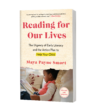It’s that time of year. We’re packing our suitcases, putting on the sunscreen, and eating Goldfish crackers aplenty! But all that time in cars or planes can be tedious for little ones, so how do you keep them occupied?
Games, of course! Here are a few of my favorite educational road trip games for kids, to keep your children engaged and learning while you travel. All of them are free or cheap, require little to no prep work, and fit into a backpack or purse. Happy trails!
Educational Road Trip Game 1: The Alphabet Game
It’s free and all you need is a keen eye! As you travel, everyone has to keep an eye out for letters of the alphabet and call them out as you see them. But it has to be done in alphabetical order. You might see them on license plates, billboards, airport gates, t-shirts, or even suitcases!
The first person to get all 26 wins. This game is great because you can play it with as many people as you want. You can make it an ongoing game throughout the trip or give it a time limit. If you want to switch it up, try doing it in reverse. Finding Z won’t be easy!
Educational Road Trip Game 2: Alpha-board
Cut a piece of cardboard into a rectangle that will fit inside your child’s backpack or whatever carry-on bag you’re using. About the size of an iPad is perfect. On one side of the cardboard, write the alphabet in uppercase letters in a mixed-up order. Do the same thing on the other side, but in a different pattern. Wrap the entire thing in clear packing tape.
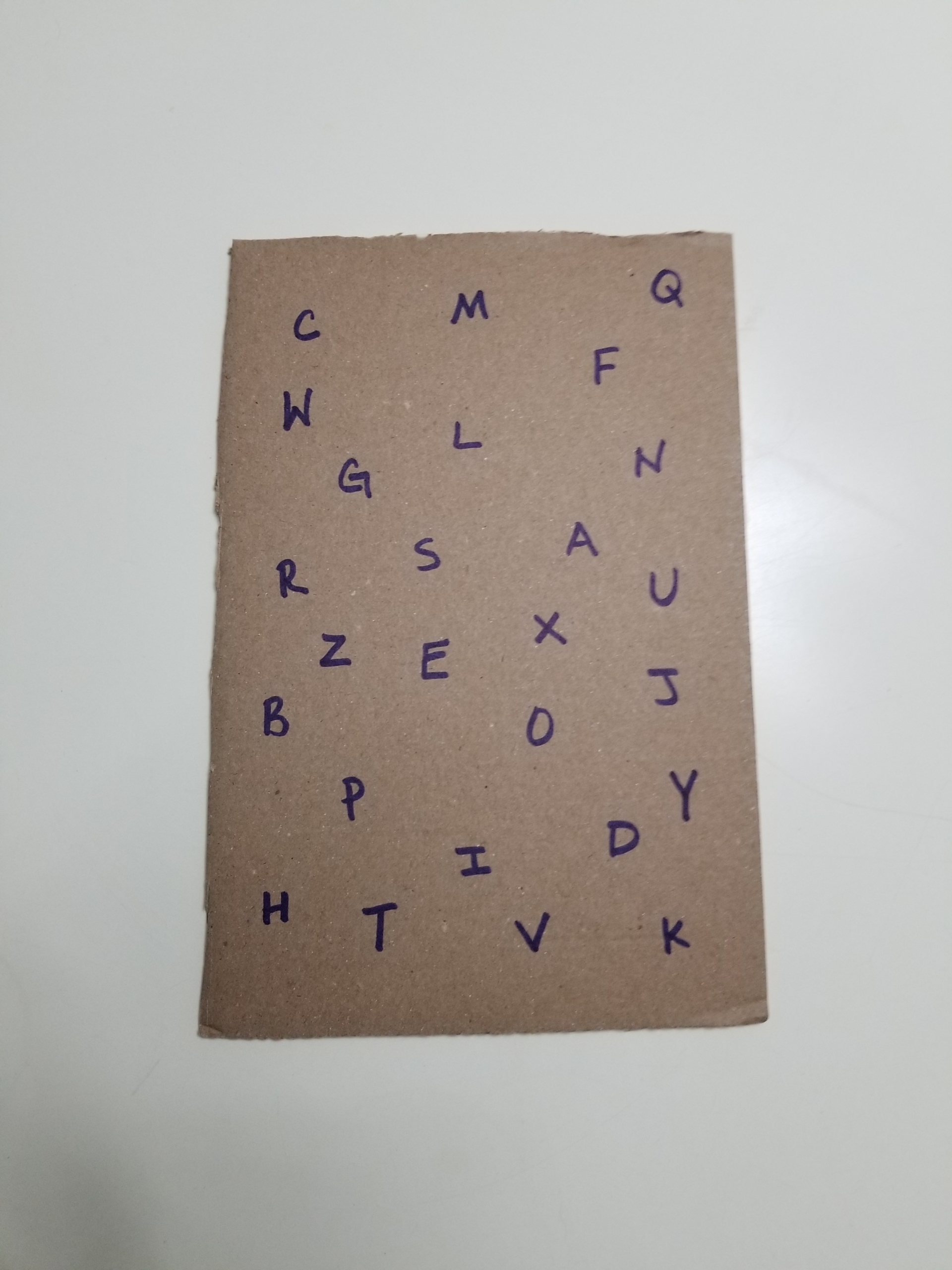
Next, on a set of stickers, write all the letters of the alphabet in lowercase letters. Hand the stickers and the cardboard to your child and let them match the lowercase letters to the uppercase letters. When they’re done, they can flip it over and do it again. If they’ve finished both sides, you can peel off the stickers and save the game to use again another day. If you want to make it a little more challenging, time them. Then see if they can break their own record!
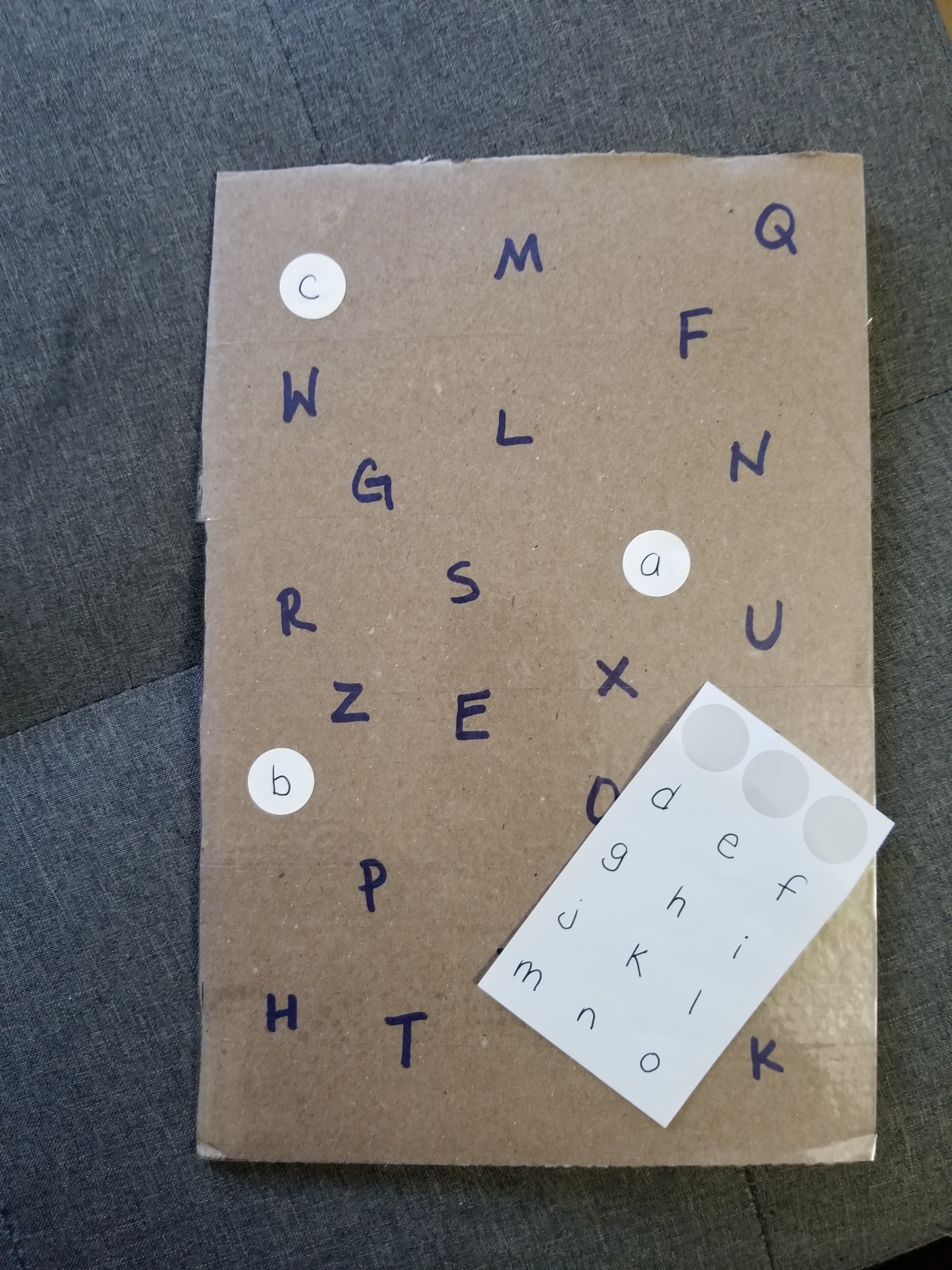
Educational Road Trip Game 3: Fill-in-the-Blank Storytelling
This one is a fun way to create original stories that are unique to your family. Start off by saying, “Once upon a time there was a …” and pause. The person next to you can say whatever they want (cat, princess, alien, mountain, etc.). Pick up the story and pause occasionally, letting everyone have a turn to add their own twist to the story.
For example: Once upon a time there was an … alien! The alien was very … slimy. The slimy alien decided it wanted to … eat cookies! But there were no cookies in the … and so on. In five minutes, you’ll have a completely crazy and fun story that no one else has ever heard before.
Tip: Record the audio of your story as your family is telling it. Later, you can write the story down and have a copy for your family to illustrate and have as a forever keepsake of your vacation.
Educational Road Trip Game 4: Rhyming Go Fish
Try our literacy adaptation of the Go Fish card game. Now, card games can often get a bit unwieldy in a moving vehicle, so I’ve got a couple of modifications you can make: To make it travel size, cut the index cards in half before you add the words and illustrations. Give kids baggies to keep their completed sets in.
To create a stable place for the draw pile to sit while playing on the go, place Sticky Tack on the bottom of a Tupperware container and stick that onto the armrest, drink tray, or seat. Then place your cards inside the container. Sticky Tack costs about $5 and is reusable!
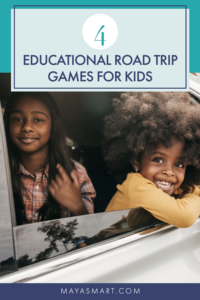
By Sarah Tiglao
Learning letters, letter sounds, and eventually sight words becomes a fun game that your little one will want to play again and again, with this easy activity that grows with your children. Read on for step-by-step instructions on how to make a fun, simple, free alphabet flash-card game to play at home or bring with you. You’ll also learn how to adapt it to your child’s skill level as they progress—plus how to keep it fun even for kids who aren’t yet emotionally prepared to handle the frustration of losing.
In order to learn to read, children must develop an understanding of letters as symbols that represent sounds, which can then be combined to make meaningful words, sentences, and paragraphs. Even once children have a strong foundation in letters and letter sounds, they’ll have to learn to recognize certain “sight words” like “said” and “whose” that appear frequently in elementary school texts but don’t follow typical spelling patterns.
Whether your child is learning letter names, the sounds associated with letters, or starting on sight words, this game will help make the memorization fun! You’ll use index cards to make your very own homemade playing cards to play an adaptation of the classic card game of War: Alphabet Flash-Card Game of War or Sight Word Game of War. You can also just print our free premade cards and cut them apart to get started playing right away!
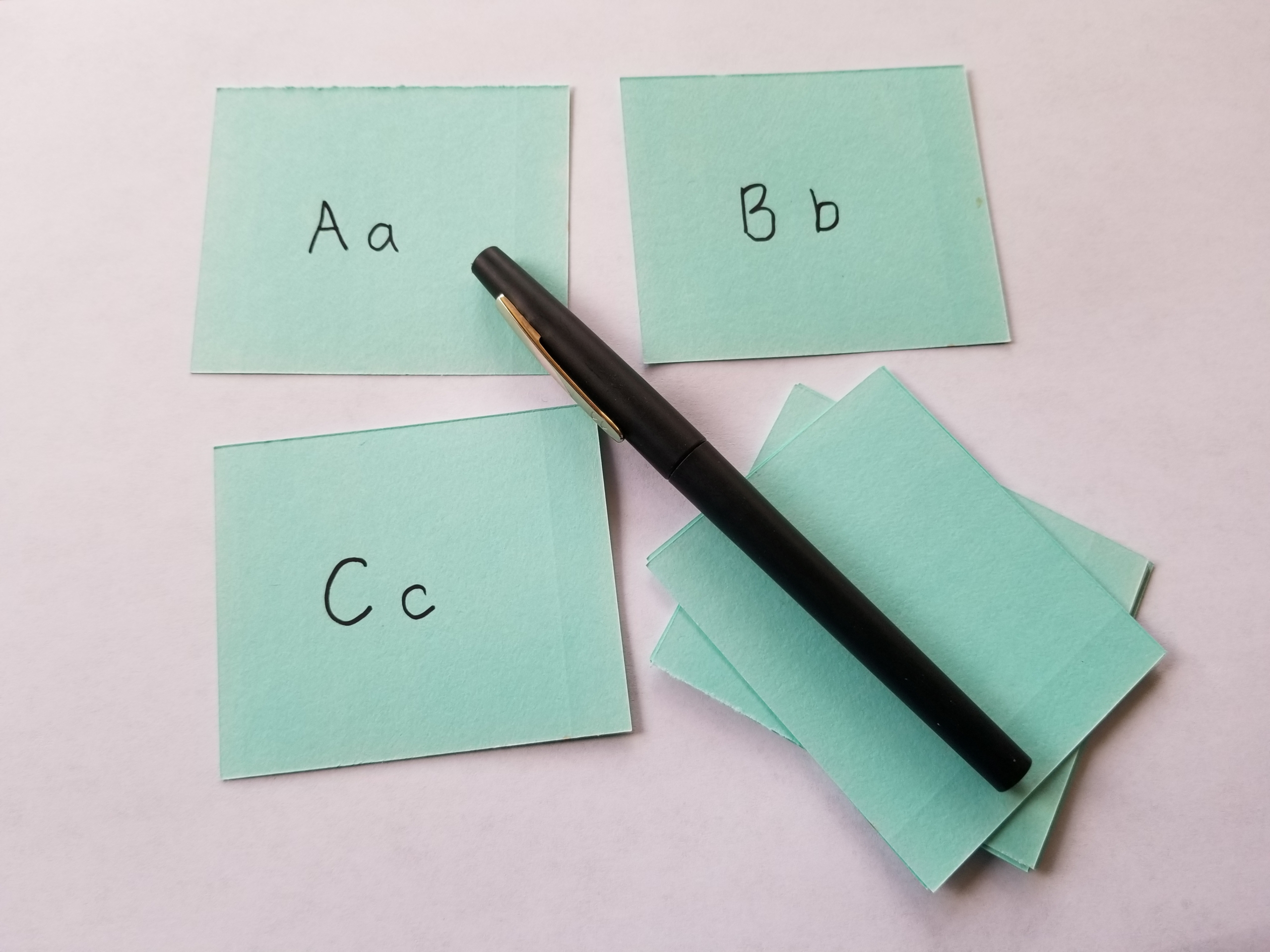
Materials:
1 pack of 3 x 5-inch index cards (or any stiff paper or thin cardboard cut into rectangles)
Markers or pens
Optional: list of sight words (use a list provided by your child’s teacher or one of these lists)
Cost: Free if you have index cards on hand or are willing to cut up some cardstock, paper, or thin cardboard to make your own! You can also just pick up some index cards for $1-2. It’s well worth it—they’re in our absolute top must-have tools for teaching reading.
How to Make Alphabet Flash-Card Game of War: To make the game, simply write one letter on each card. (Use index cards as they are, or cut them in half to make the cards fit more easily in little hands.)
I recommend you write each letter on two cards, so that each comes up twice in a game. For the very youngest of children, write only the uppercase version of the letters. Once they have mastered those, add lowercase letters to the mix.
How to Make Sight Word Game of War: Write one word on each card. Again, write each word from your list on two cards. It’s often a good idea to start with just a small list at first and gradually add more words as your child is ready for them.
Tip: Include a majority of words your child knows or can sound out, to give them lots of chances to feel like winners and encouragement to stay engaged!
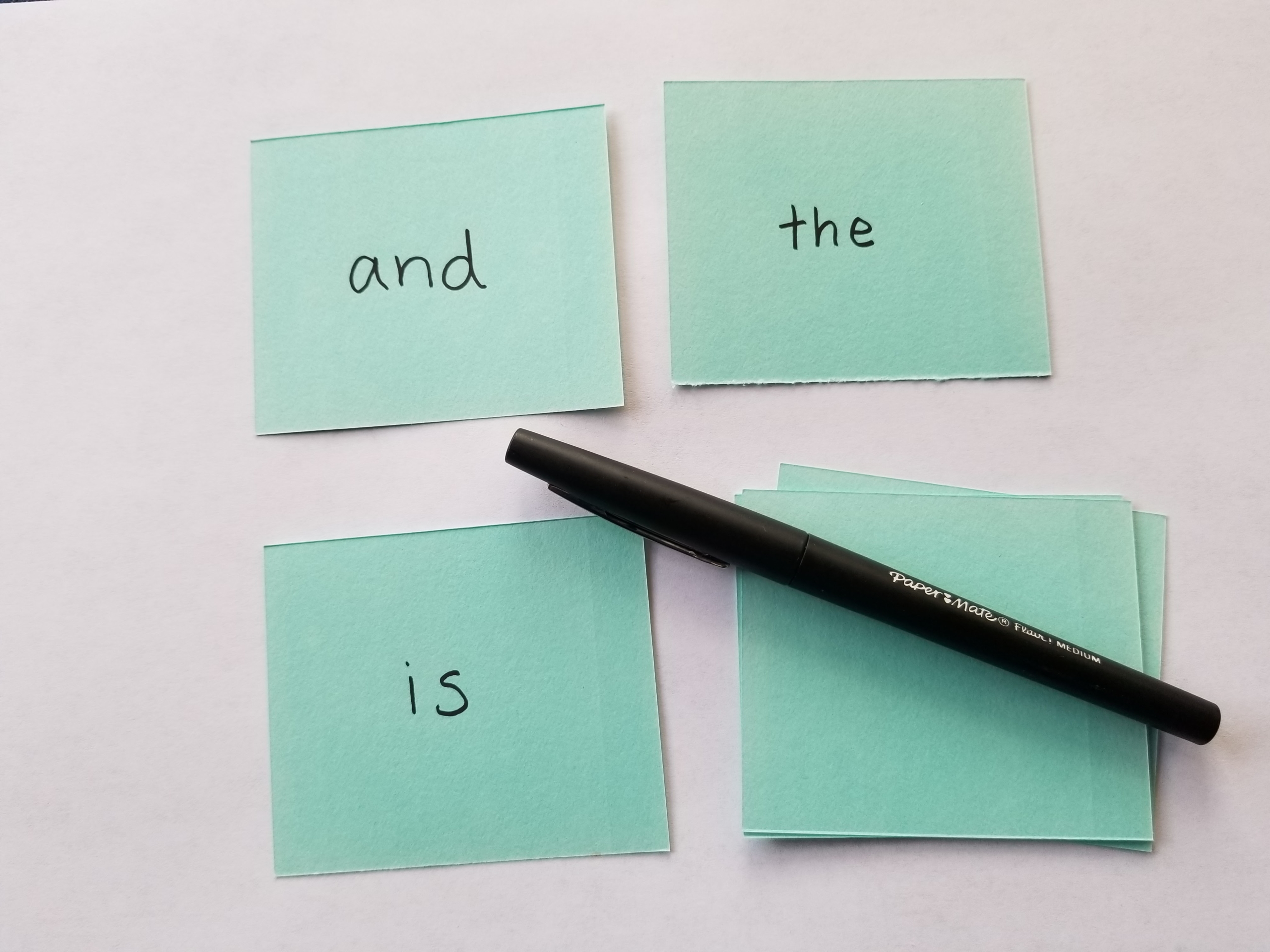
How to Play Alphabet Flash-Card Game of War and Sight Word War:
- Shuffle or mix all the cards together and then deal out half to the child and half to the parent.
- Say “1-2-3-War!” and both simultaneously show your top card. Have your child try to identify the names or sounds of the letters, or read the sight words. The child gets to place either or both cards on the bottom of their pile if they can read them. When they can’t read one, explain what it says and add it to the bottom of your own pile.
- Keep playing until your child has all the cards in their pile.
No-Losing Variation: Obviously, the aim of this game is early literacy, not making our kids feel like losers if they don’t yet know how to read a letter or word. If your child is very new to recognizing letters or reading sight words, or you are concerned they will get too frustrated by losing their cards, try this variation:
Rather than losing their cards when they can’t read them, let your child hold onto their own cards that they can’t read, and only withhold your own cards when they can’t read them. Tell what the cards say and place them on the bottom of the two piles. Or even replace them on the top for very young kids—remember the aim is for them to keep playing and keep learning! You can always up the competitiveness of the game later.
Letter-Sound Variations: Once your child has mastered the names of the letters, it is time to start learning their sounds. In this version, your child wins cards by knowing the sound each letter makes.
This version can also become more complex as your child develops. Initially, you will want to start with just the 26 letters in the alphabet (for vowels, teach them the short vowel sounds, e.g. A is for apple), but once they master those sounds, you can add in phonemic chunks like /th/ /ou/ /ng/ and so on. Recognizing these patterns will be hugely helpful as they begin to read.
Let us know how your child likes Alphabet Flash-Card Game of War and if you come up with any fun adaptations!
Sarah Tiglao is a writer, designer, and mother of three energetic boys; her recent works include a children’s book called Christmas in Quarantine.
Alphabet card photos by Sarah Tiglao
Pin me for reference
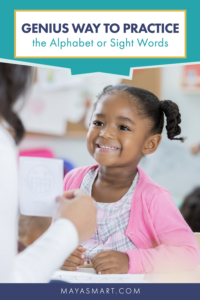
Teach a person to read and you open a door—not only to an unparalleled world of wonder and entertainment—but also to independence, freedom, and success.
Yet those doors are remaining closed for too many: In 2019, the National Assessment of Educational Progress showed that two-thirds of the nearly 294,000 fourth- and eighth-grade students who took the test couldn’t locate information that’s stated in a text, infer the main ideas of an article, explain the theme of a story, or evaluate a text from multiple perspectives. Wow.
The assessment has shown decade after decade that a minority of students meet grade-level reading expectations: The majority of U.S. students have limited reading skill. Worse still, the latest scores reveal that our lowest-performing students are worse readers than the lowest performers ten years ago.
This site is dedicated to the proposition that supporting today’s children—tomorrow’s citizens—to develop full literacy is one of the most important things any of us can do for our neighborhoods, community, country, and world. Read on for ways to support this goal, whether or not you have kids of your own.
Support Public Libraries
Public libraries not only provide incredible collections of books and resources freely available to all, they also offer early literacy programs and literacy support for families.
These include story times and other free events, raise-a-reader programs demonstrated to significantly increase the amount families read aloud to kids and the value they place on shared reading, parent education around early literacy, multilingual programming, campaigns to distribute free books that families can keep permanently, and more.
Supporting your public library is a crucial way to advance the cause of literacy for all.
Check out these related articles from MayaSmart.com:
The stunning Austin Central Library has scored high marks for its green power, water-recycling systems, daylight use, views and community connectivity. Yet, we should feel challenged — not satisfied — by this last designation. We’ve built an impressive library, but what must we do to ensure that the people come, including the broadest swath of our community possible?
A particularly moving scene in the film Hidden Figures takes place not at NASA but in the public library of Hampton, Virginia. It got me thinking about the incredible barriers to adult education and career advancement that continue to persist, helped by complex systems of discrimination and segregation.
Support Literacy Nonprofits
Going by the statistics, the deck is already stacked against the three-quarters of children who show limited reading skills in the national assessment.
Research shows that childhood literacy is crucial for achieving further academic success. Students that can read by third grade are less likely to drop out of high school and subsequently less vulnerable to poverty and unemployment. Adult literacy directly correlates with quality of life, as well. What’s more, around 70 percent of U.S. prison inmates operate at the lowest literacy level.
From poverty to equity to criminal justice, just about any social issue you might care about can be positively impacted by supporting literacy. Get started by donating to a national literacy effort, or support an organization in your area with a gift of time, money, or resources.
Check out these related articles from MayaSmart.com:
Austin offers a plethora of options for supporting literacy initiatives. Explore eight local nonprofit organizations in the Austin area that offer opportunities to help open the door to literacy for all. Even supporters outside the area can help with these important initiatives by donating to support their life-saving and life-affirming work.
Sometimes the best thing an emergency room doctor can give a kid is a book. In a world where low-income children hear 30 million fewer words than more affluent peers, literacy’s a true life-saver. Just ask ER doctor Robin Foster, who says she makes as much impact with social engagement as with medical intervention. Foster helped found in-hospital programs dedicated to child advocacy, youth violence prevention, and literacy.
Share Early Literacy Resources with Parents
As demonstrated above, we can’t assume that children will get the reading instruction they need to thrive in school. Most schools simply aren’t equipped to get the job done without outside help.
Instead, parents and caregivers need proven information on fostering literacy at home—ideally from the very earliest days of babyhood. You can help children beat the odds by sharing such science-backed information far and wide. (If you’re ready to take it to the next level, you might even seek out opportunities to give brain-building literacy support to kids in your community or network, by volunteering as a tutor, offering to host a neighborhood story time, or engaging with schools or community groups.)
MayaSmart.com offers a variety of articles and tips about evidence-based ways to develop key literacy skills from birth onwards. Begin with the following posts, then direct any parents, caregivers, or early-childhood educators you know to our many literacy activities for fun and easy hands-on ways to build key skills.
Discover science-backed insights into boosting brain capacity, stimulating language development, and spurring vocabulary growth by sharing reading from day one.
Get a rundown of the top reasons for caregivers to add nursery rhymes—classic, remixed, or brand new—to their daily routines with kids.
The reassuring authors of raise-a-reader books often prescribe a chill pill and a nightly dose of bedtime stories to parents anxious about their kids’ reading. In reality, there’s so much more than reading aloud that we should do to support children’s literacy.
A robust body of research dating back to the 1980s positively associates interactive parent-child reading with language-development gains. Learn seven research-backed ways to capture a child’s attention during story time and give them all the vocabulary and brain boosts possible.
How are you supporting literacy for all? Let us know in the comments, or use the buttons below to connect with Maya Smart on social media!
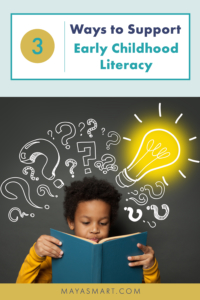
By Carlene Murray
As a mother of three young children and an early childhood educator, I’m always looking for ways to help my charges learn about other cultures and traditions from around the world, as well as explore their own heritage. I’m fortunate to live in an area where my kids see faces of many colors everyday, and nothing warms my heart quite like seeing a group of children from different backgrounds bonding and playing together. But no matter where you live, reading a wide variety of books about different experiences can help your little ones grow up to be open-minded citizens who are accepting of others.
Ramadan is one of the most important times of year for Muslims, a holy month of fasting, prayer, and introspection that’s meant to help believers strengthen their faith, self-control, gratitude, and compassion for the less fortunate. Children are exempt from fasting, but they can engage in introspection and cultivate these same qualities through thoughtful shared reading, including sharing Ramadan books for kids. (Note that Ramadan is celebrated in the ninth month of the Islamic year, which is slightly shorter than our Western calendar, meaning the event happens at a different time each year.)
For me, reading to my children about Muslim traditions is a way of teaching them part of their cultural heritage. But reading books that tell about different cultural celebrations is also one of my favorite ways to celebrate our society’s rainbow of diversity. Families from all religious backgrounds can enjoy the following Ramadan books for kids while gaining understanding of why this time of year is so important for Muslim families around the globe.
Like this post? Share it!
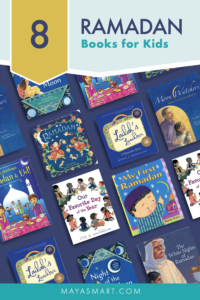
And did you know that dogs can be comforting, receptive audiences for children who need practice reading aloud? Furry friends make great listeners. They never interrupt with corrections like well-meaning parents and siblings sometimes do.
So the next time you do a read-aloud with your kids, invite your pets along to listen. Even if you don’t have a dog, you can still enjoy these picture books about puppies to warm your heart and teach your children about our furry friends—and maybe grab a stuffed puppy for your audience.
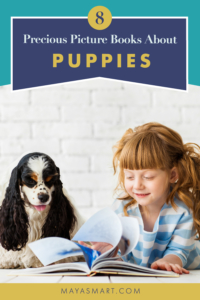
By Laila Weir
Who says Easter baskets have to be filled with all sweets? Lighten up on the sugar a bit and add some enrichment to your child’s Easter with a few fun and literacy-supporting Easter basket gifts. Below you’ll find links to tutorials for three Easter-themed recycled art projects. They’ll teach you to make totally free, eco-friendly, and easy DIY Easter basket stuffers!
What’s more, they’re educational: All three projects support oral language development and key early literacy skills that lead into important aspects of reading and writing.
You’ll learn to turn plastic Easter eggs into maracas and how to use them to develop your child’s rhyming skills. You’ll discover how to make old building blocks into storytelling dice that you can use to engage your child in spinning tall tales. And you’ll get instructions and printable templates for upgrading a paper lunch bag into an adorable bunny puppet, along with tips on how to use it in a fun literacy activity.
If you want another way to celebrate Easter with your little one and build their early literacy skills at the same time, read Chrysta Naron’s post on how to help your kid learn to read with a sight-word Easter hunt, too!
Easter Bunny Paper Bag Puppet
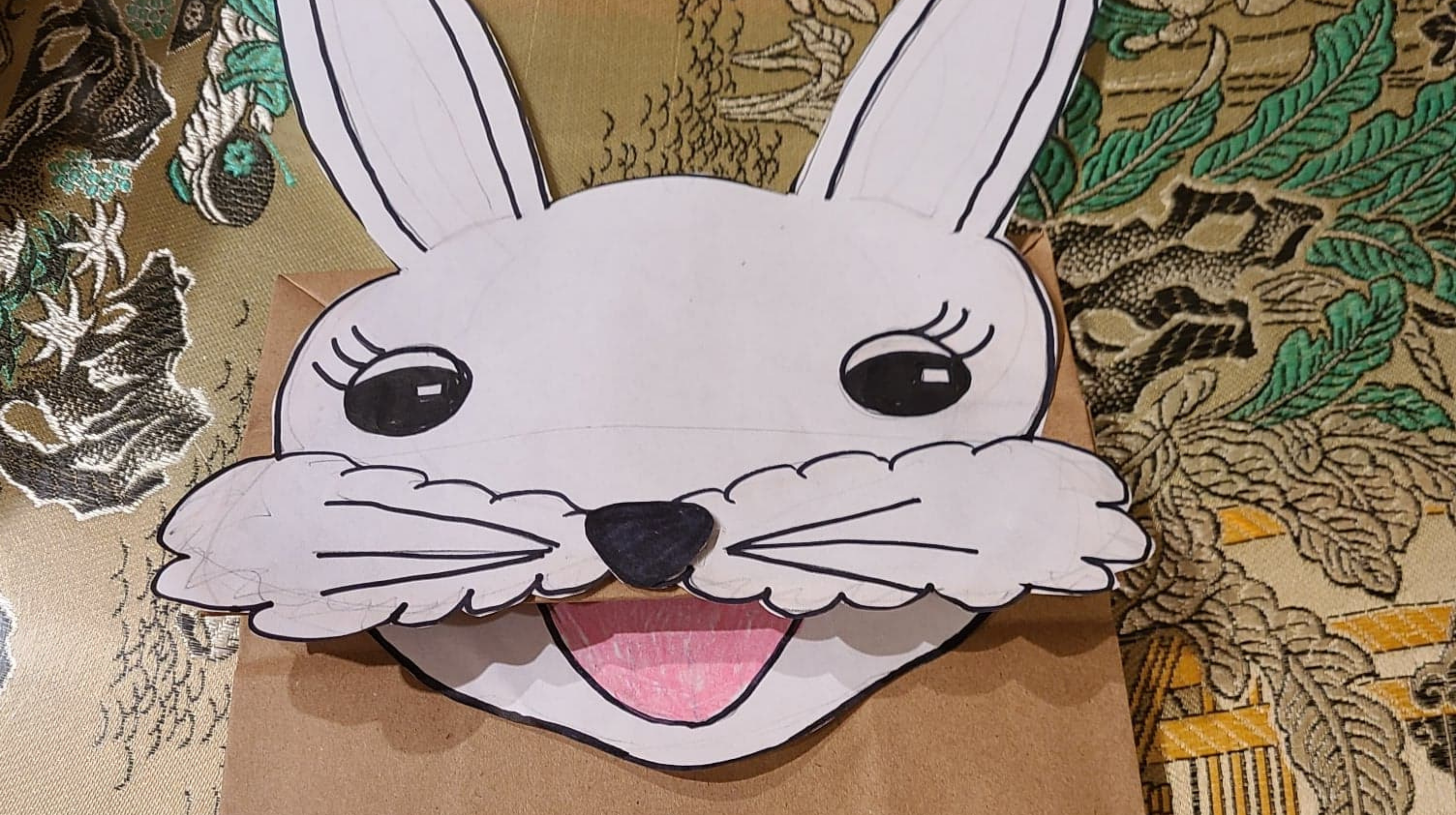
In this sweet Easter craft and activity, you’ll learn how to make an easy but adorable Rhyming Rabbit Easter Bunny puppet. Then you’ll help your child use their bunny to recite rhymes, from nursery rhymes and songs they know to beginner poems to come up with themselves. Using the bunny makes rhyming more fun, but it also has a deeper benefit: Reciting through a puppet can help children feel less self-conscious and free your budding poet or songster to get as lyrical or silly as they like.
Upcycled Plastic Easter Egg Maracas
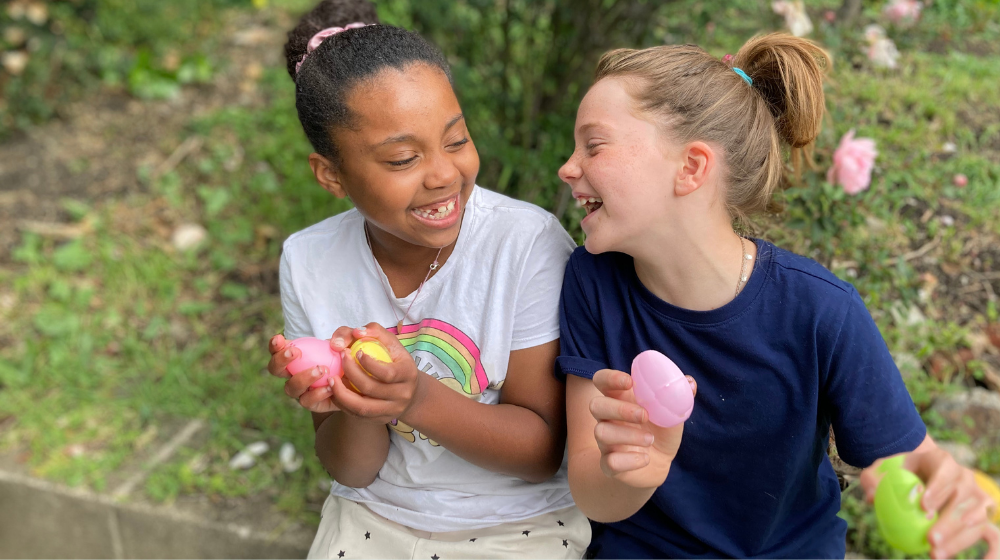
In this super-easy, two-step craft, you’ll upcycle old plastic eggs into colorful musical instruments to welcome in the spring with a vibrant lyrical celebration. These cute maraca-style shakers are perfect for getting kids moving and learning! Check out the link for the instructions, plus detailed tips on how to use your child’s new shaker for maximum brain-building benefit.
Recycled Storytelling Dice
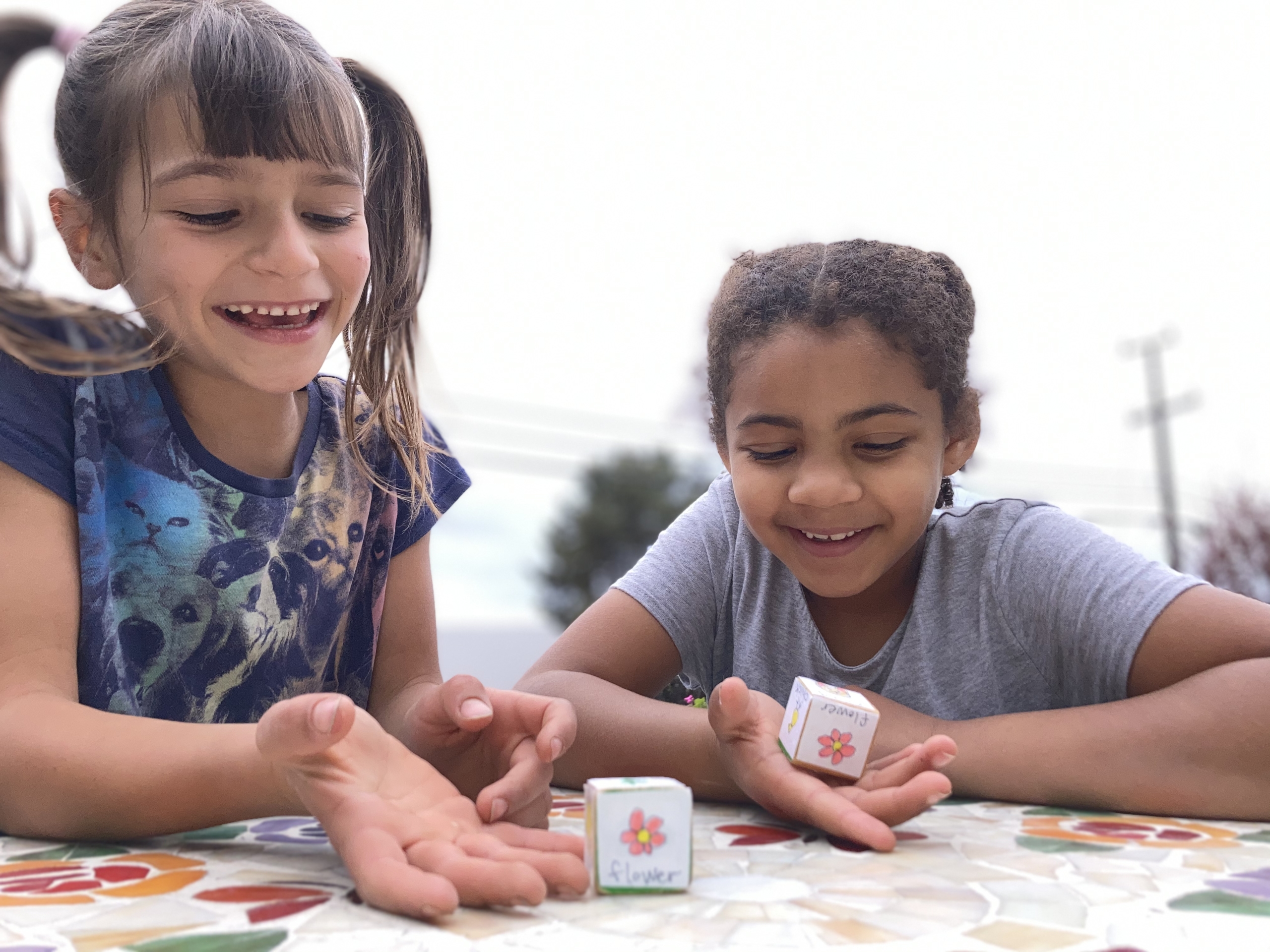
We love storytelling dice to get the ball rolling on inventing stories together with your child. This helps kids enrich their oral language, deepen their comprehension, expand their vocabularies, and develop key skills underpinning reading fluency. Plus, it’s a super fun game to play together! Sure, you could buy some of the many storytelling dice out there, but why not save the planet and your pocketbook by making your own from recycled materials, instead? In this tutorial, you’ll learn how to upcycle a couple of old building blocks into your own Easter-themed DIY storytelling dice.

By Chrysta Naron
Henry was a Go Fish shark. He was a legend among my Pre-K classes: The best Go Fish player you’d ever seen under the age of five. He played it every day in class. He played it to the point where none of the other kids wanted to play anymore. But Henry refused to play any other games.
It happened to be April—aka National Poetry Month—and our class was focusing on rhyming. So I decided to freshen up Go Fish and make it all about rhymes. The result was this awesome free rhyming game for kids that you can easily make at home. The children loved getting to help create the game, and so they were all eager to play. And as for Henry, it was close enough to the regular card game that he was happy, too. Everybody won!
Rhyming is a very important literacy skill that prepares kids for reading. Children love to be active participants in their learning, and they love it even more when grownups play with them. What’s more, this rhyming game is free and only takes about 10 minutes to make! This game ticks all the boxes, in my book.
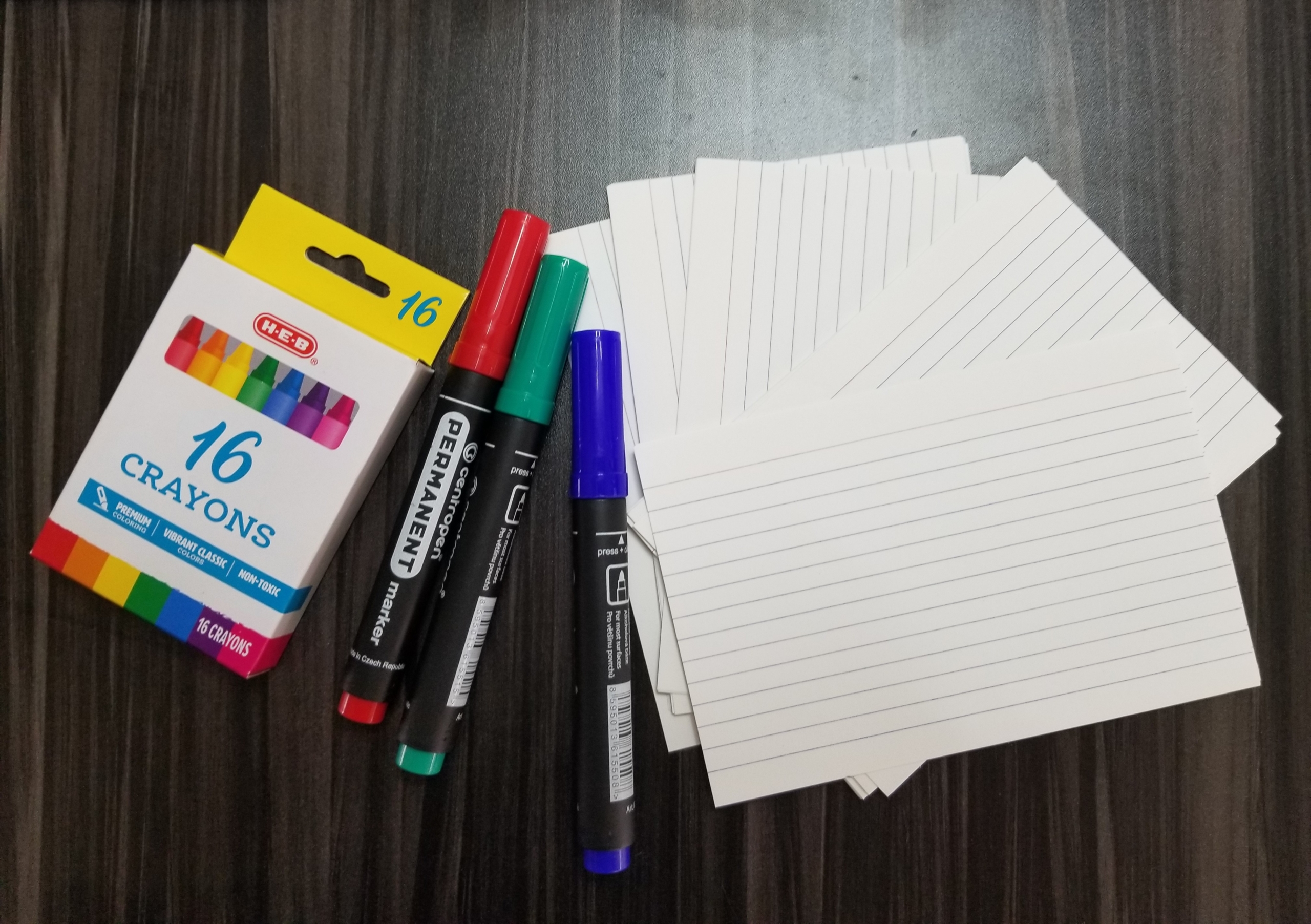
Materials:
- Index cards (or sturdy paper/thin cardboard to cut up)
- Pencil, crayons, etc.
- Scissors, if using paper to cut up
Cost: It’s free! If you don’t have index cards on hand, just use cardstock or thick paper to cut into cards. You can even get creative and use thinner cardboard from boxes or containers that you would have recycled.
However, it’s well worth getting index cards on hand (they’re one of our must-have tools for teaching kids to read), and you can usually pick some up for under $2!

Step 1: Gather or cut out 40 index cards, and create 10 sets of 4 cards each.
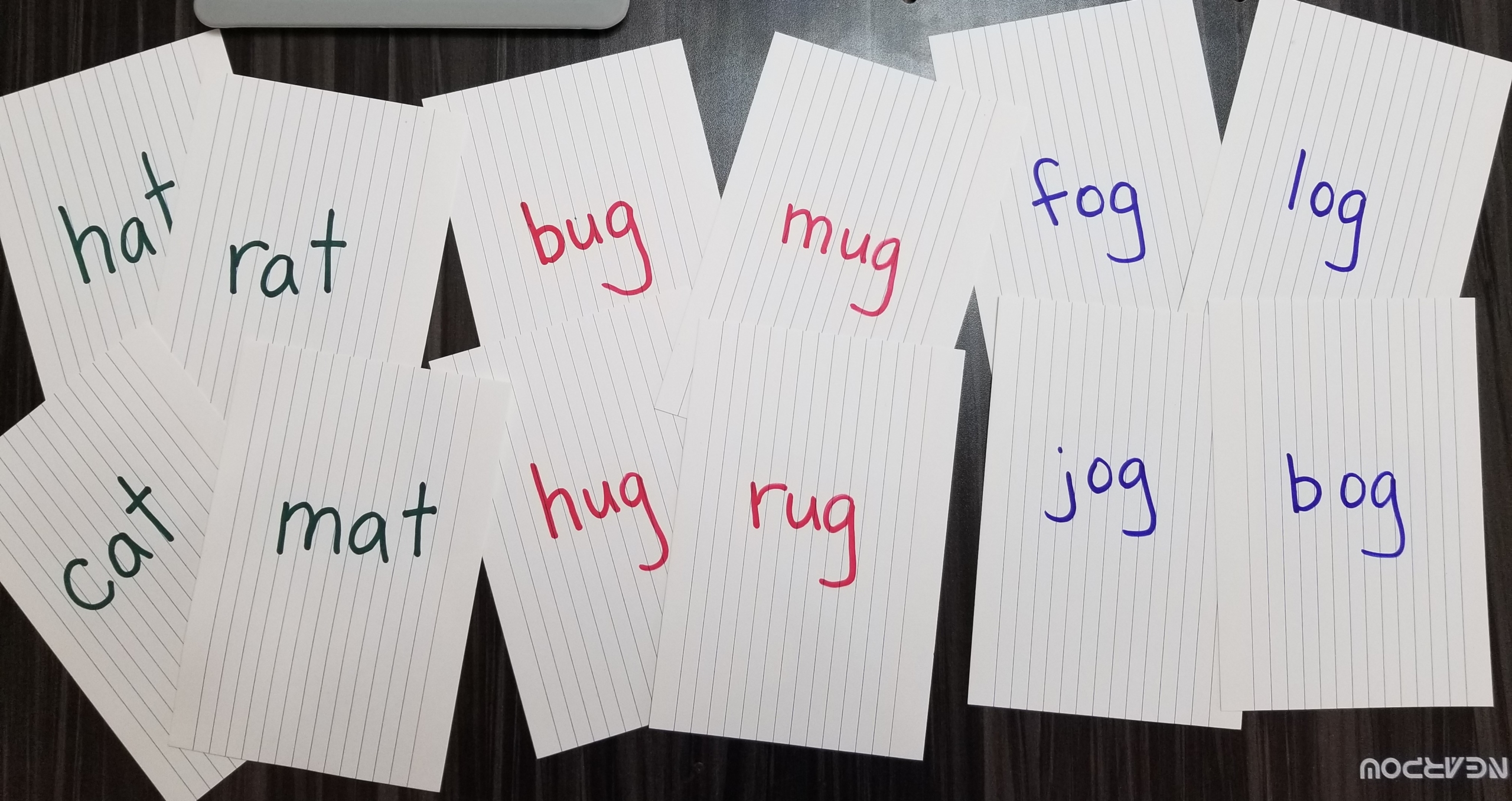
Step 2: Each set of four cards will be its own rhyming family. With your child’s help, choose four rhyming words for each set, and write one on each card of the set. For example, one set might be “cat,” “sat,” “mat,” and “hat.” Another set might be “dog,” “log,” “frog,” and “bog.”
Tip: Write the words in crayon or pencil if your cards are on the thinner side, because markers may show through on the other side!
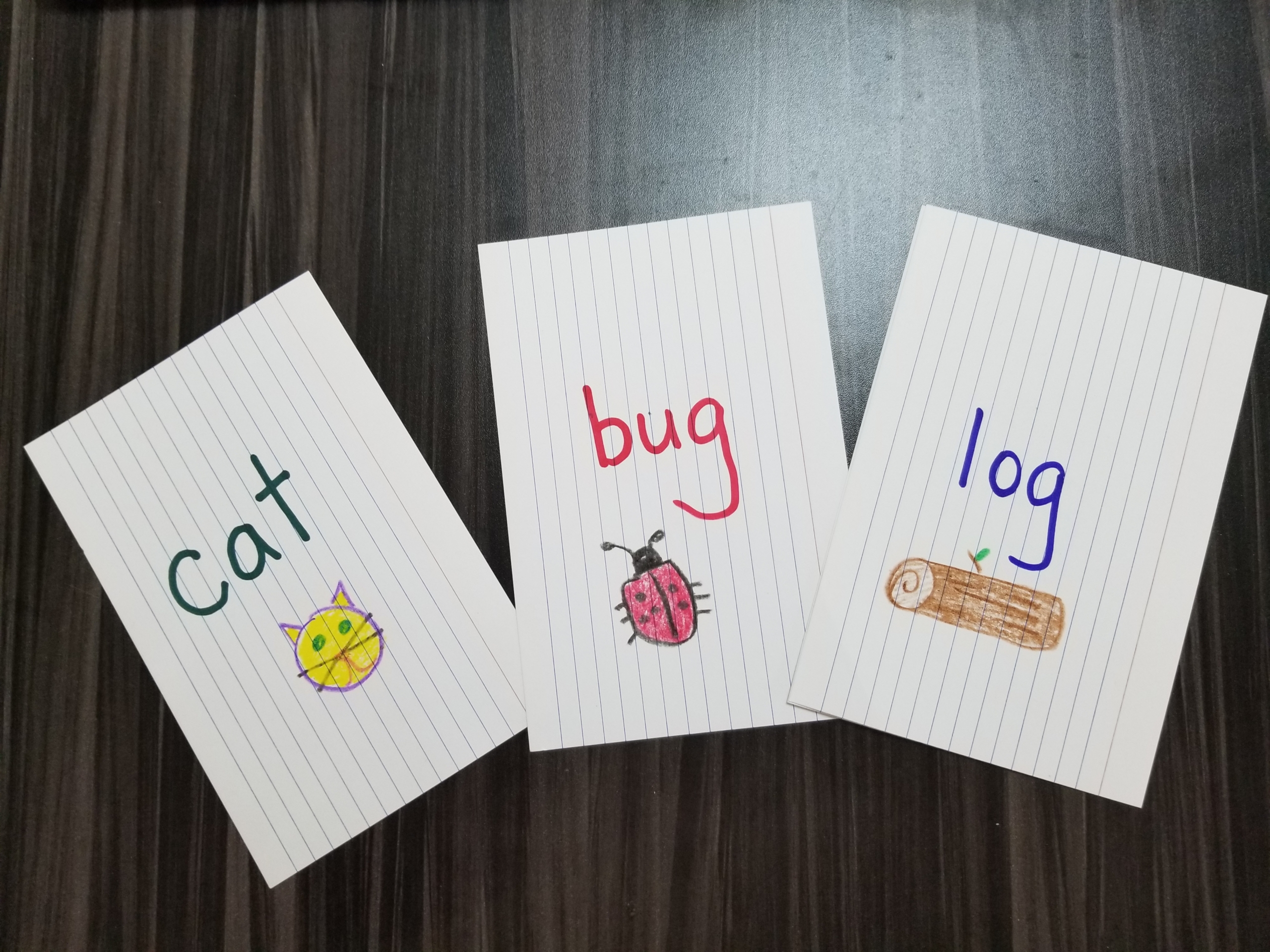
Step 3: After all the sets are complete, decorate with simple drawings of each item! This allows kids who aren’t reading yet to play. Rhyming is an important skill for pre-readers, so this step is key!
Tip: Make sure to only decorate the side with the word written on it. The backs should be blank, to avoid giving away matches during the game.
Step 4: Shuffle the cards and play Go Fish. The regular rules of seeking out matching pairs apply, but instead of asking for a number, ask for a rhyme. The person with the most sets of rhymes at the end wins!
As your child gains reading skills, you can modify the game. You can create sets that match in alliteration (i.e., their starting sounds match, like “cat” and “cup”) or make sets of two with homonyms (words that sound the same but have different meanings).
I’d love to know: How does your family make time to rhyme? Share your ideas!
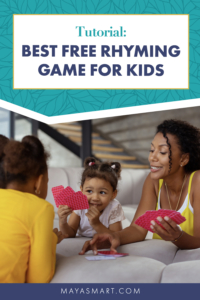
I’ve always been proud of the fact that my daughter loves to drink water! Ava is a teenager now, but from the time she was young, I instilled in her the value of this essential resource and talked about how vital water is for not only our bodies, but also our planet. We all know that our bodies are largely made of water, but did you know that 71 percent of the Earth’s surface is water, as well?
March 22 is World Water Day, a day to celebrate and reflect on the importance this key molecule holds in our world. Here are 10 wonderful picture books to help you and your children learn about the world of water, and how crucial it is to keep this precious resource safe and abundant.
Which water picture book did your child enjoy the most? Let us know!
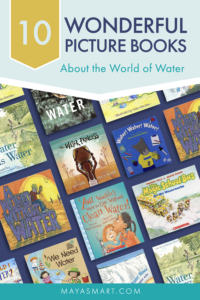
May is the time to celebrate and lift up the mothers and mother figures in our lives. But rather than just limiting our celebration to one day, let’s make a DIY Mother’s Day gift that lets them know how much we appreciate them every day.
I love to kick off most kid projects with, you guessed it…a book! While there are many incredible picture books for this special day, I am particularly fond of A Chair For My Mother by Vera B. Williams. Most other Mother’s Day books focus on the emotion of love, the bond between parent and child, and simple acts like hugs and spending time together. This book is a unique narrative about a girl, mother, and grandmother who lost everything in a fire. It shows a community coming together to help people in a hard situation, and three generations of women dreaming and working together to support a loving mom. It’s a beautiful story with colorful illustrations that has a constant place in my home and classroom libraries.
In A Chair For My Mother, the characters save coins in a huge jar to one day buy a special chair for the mother to relax in when she comes home. That’s the inspiration for our Mother’s Day activity, but instead of putting coins in the jar, we’ll put love notes! Writing can be daunting for kids—they might love to read, but when asked to spell something on their own, they freeze. Through doing this activity together and giving it a personal purpose, writing becomes something a child wants to do.
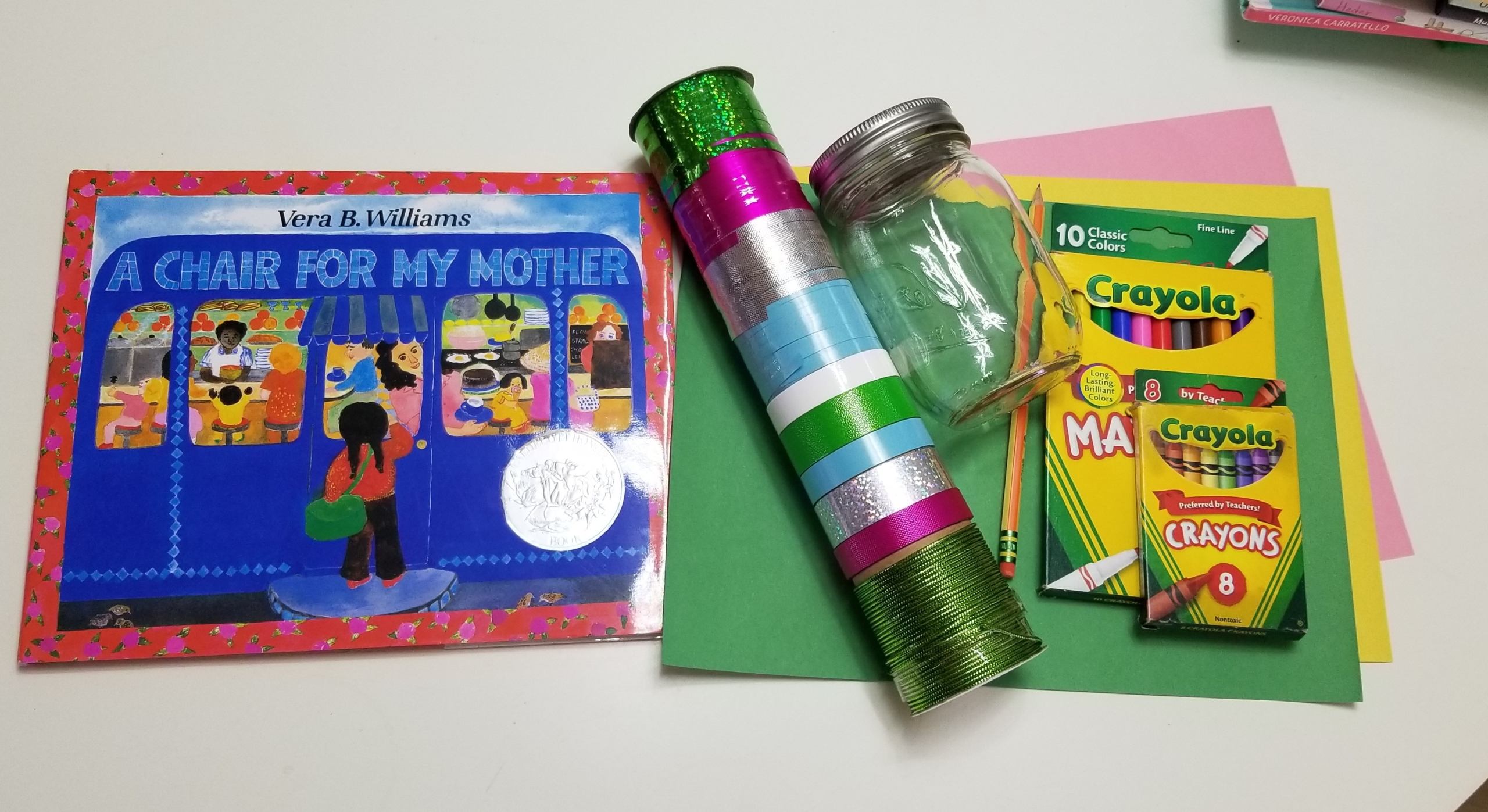
Materials:
- A Chair for My Mother by Vera B. Williams
- A jar (clean it out and let dry completely before beginning)
- Yellow, pink, and green paper (or any three colors!)
- Scissors
- Pencils, markers, and/or crayons
- Ribbon or twine
- Hole punch (optional)
Cost: Nothing, if you can get the book from your local library. Upcycle a cleaned-out food jar and reuse any scrap of ribbon you can find (you don’t need much). If you don’t have materials on hand, you should be able to get all the craft supplies for under $10.
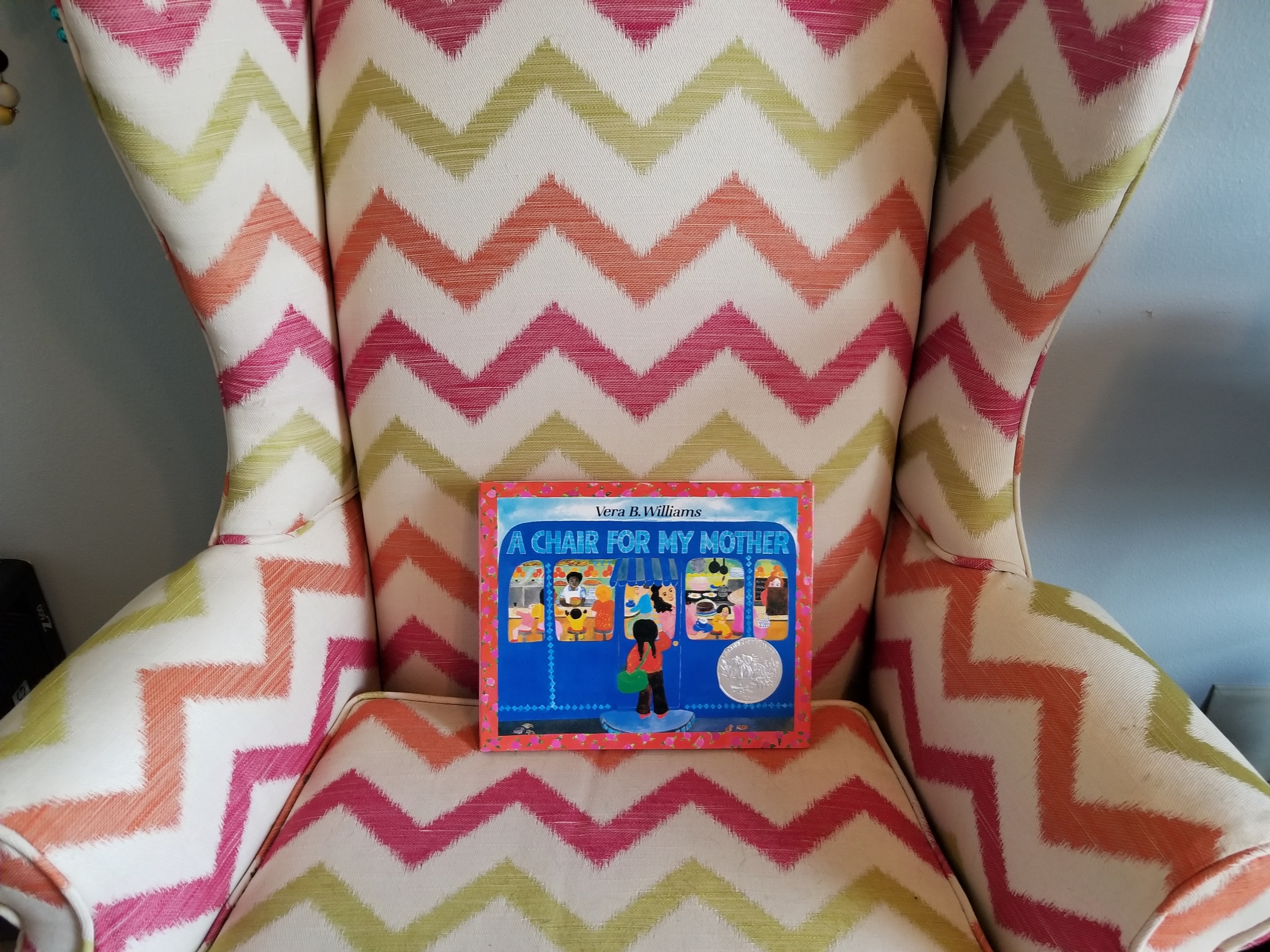
Step 1: Find a favorite chair, cozy on up, and read aloud A Chair for My Mother to your little one!
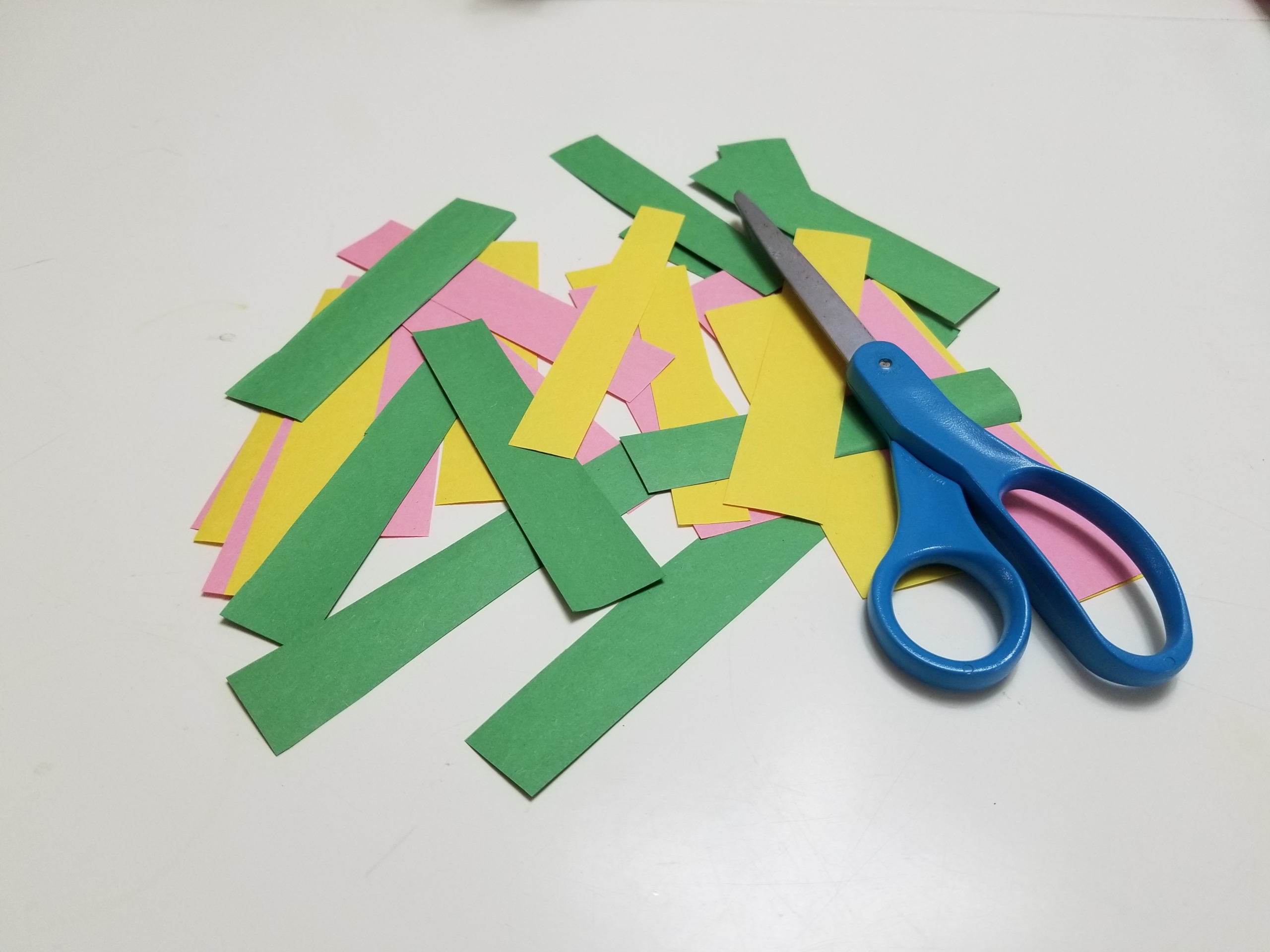
Step 2: Cut out a bunch of strips of each paper color, making sure they’re wide enough to write on. I recommend cutting about 10 of each color, but any number is fine. It’s about your child’s comfort level with writing and the amount of time your family has to spend.
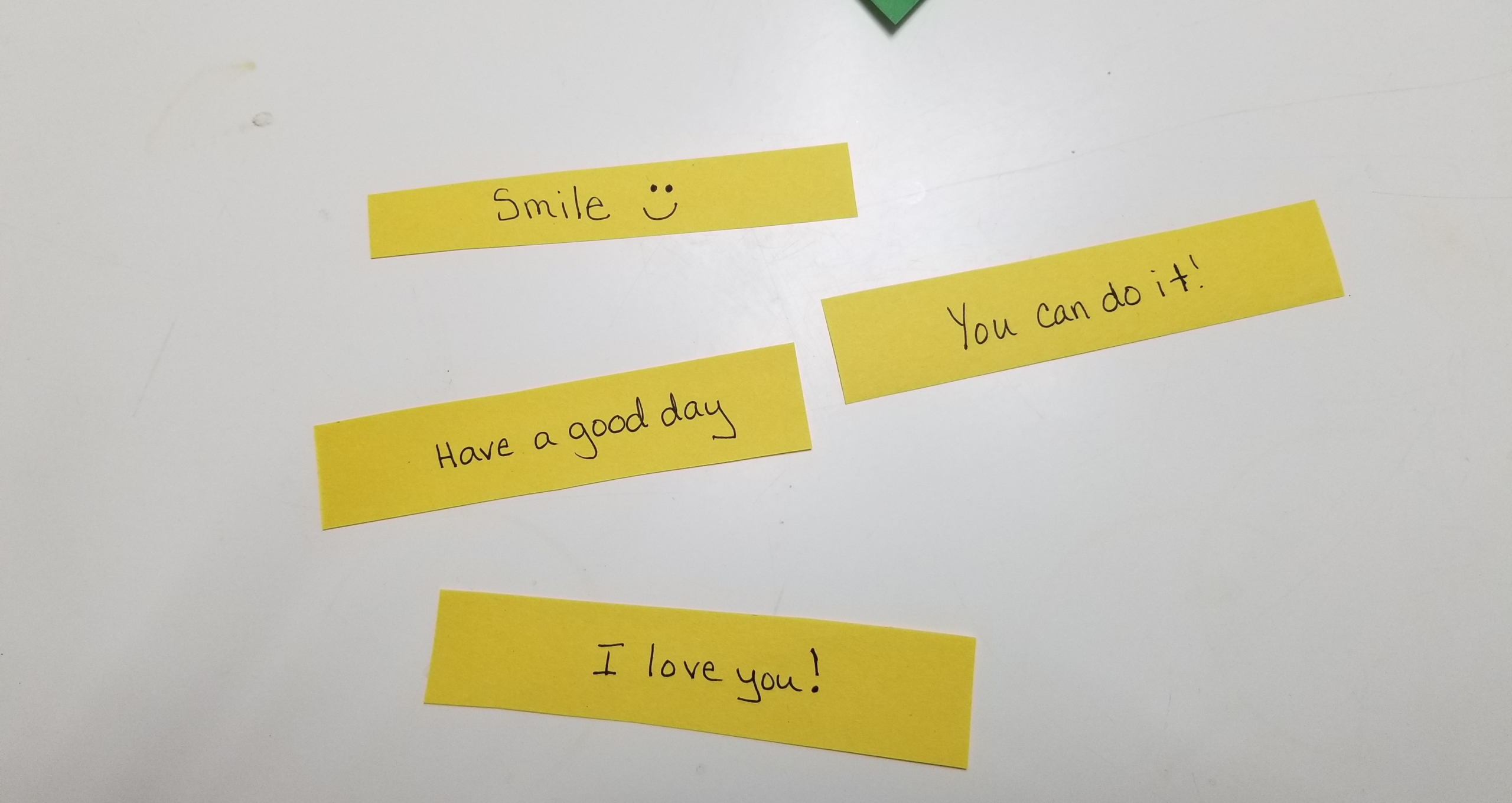
Step 3: On the yellow strips, help your child write encouragements. Encouragements are statements that can brighten someone’s day without being moment- or person-specific. Examples: “You’ve got this!” or “Have a great day!”
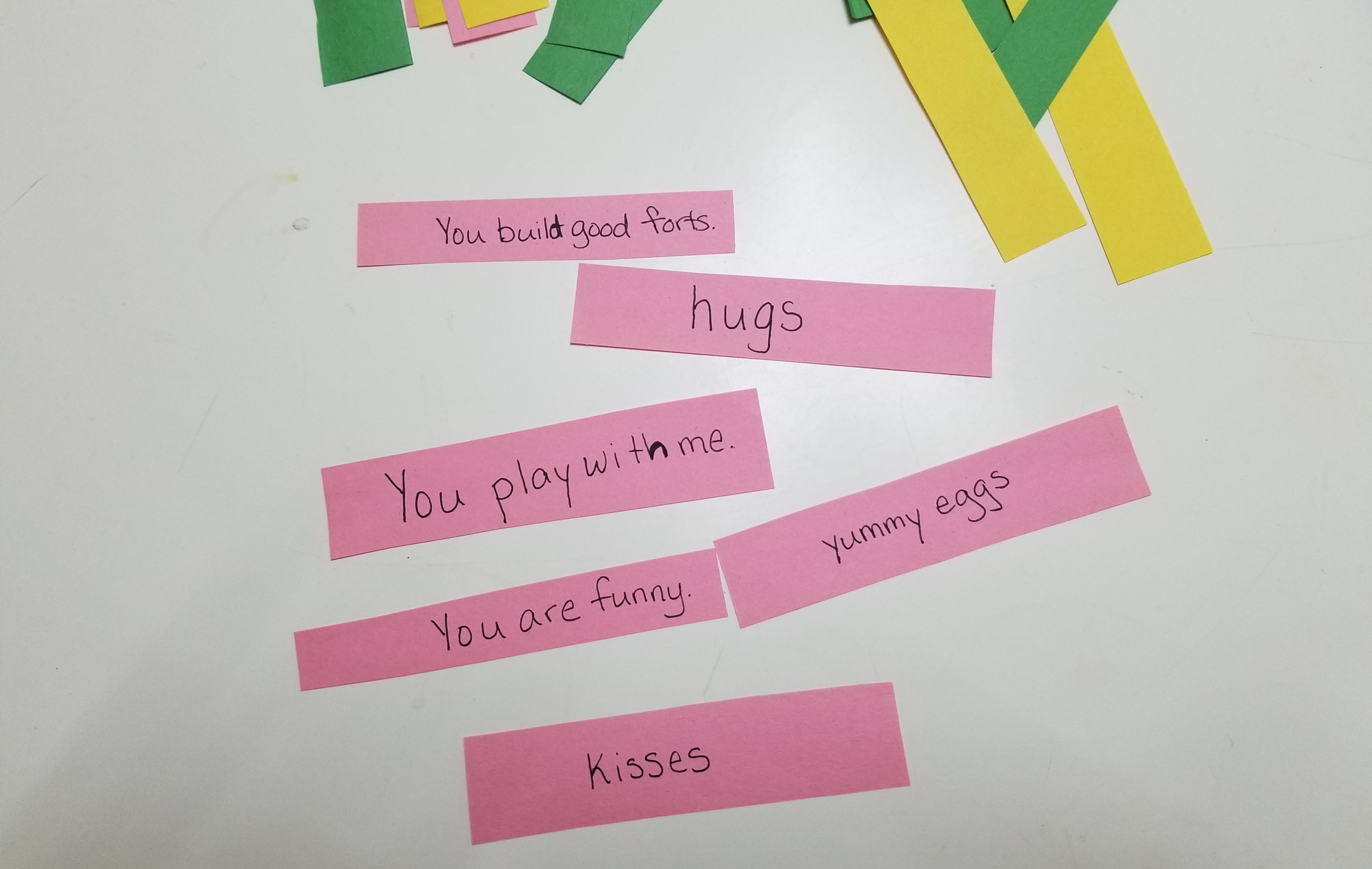
Step 4: On the pink strips, help your child write things they love about their mom or loved one. If your child is younger, it can be a single word like “hugs.” The older your child, the more complex their comments can be. Upgrade to “gives me hugs” or “Mom gives me the best hugs.” Adjust to your child’s skill level!
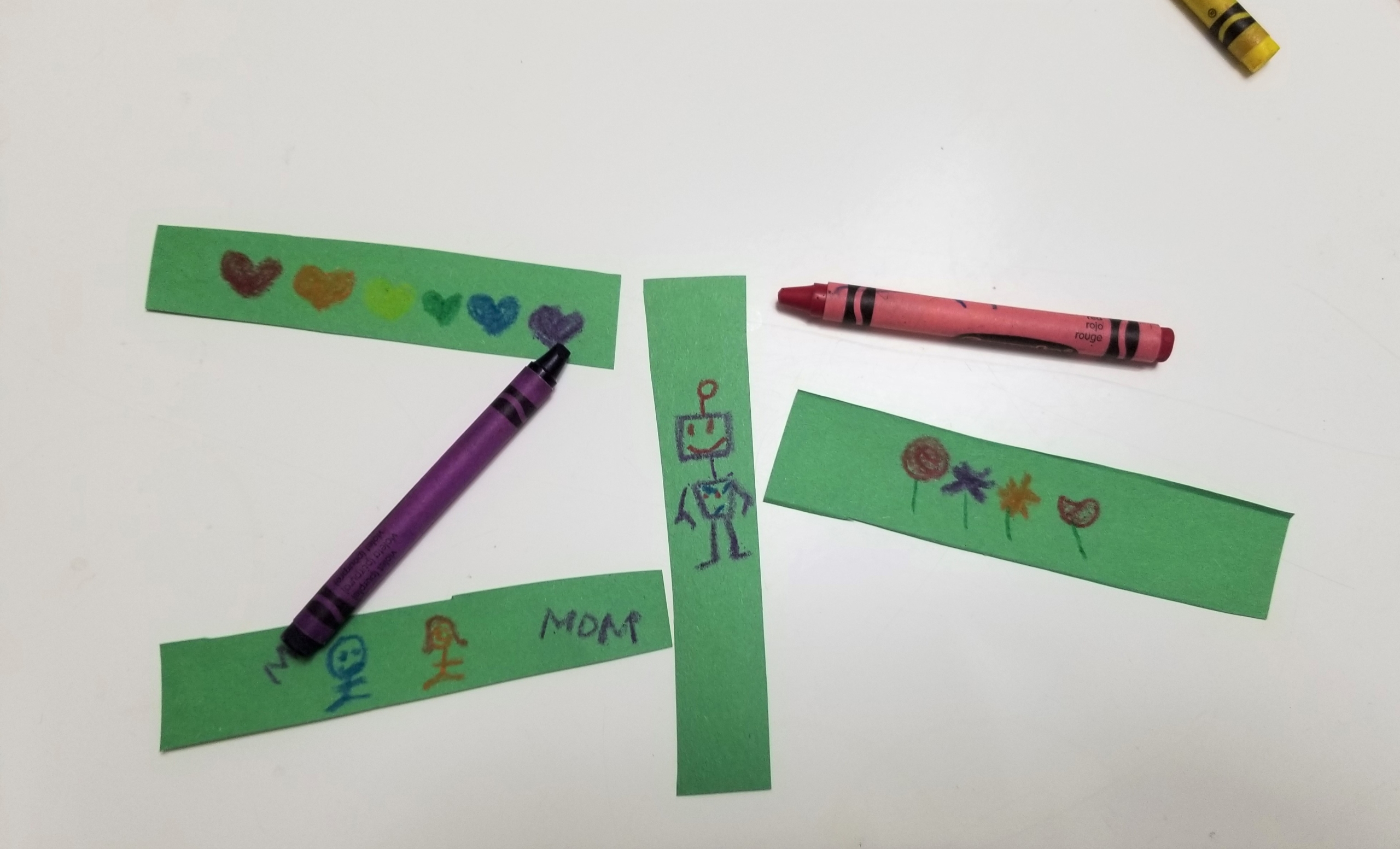
Step 5: On the green strips, let your child draw pictures. They can be silly scribbles, tiny rainbows, pictures of your family, or anything else they want. Let them express themselves however they please.

Step 6: Fold all of the notes in half and place them in the jar. Put on the lid.
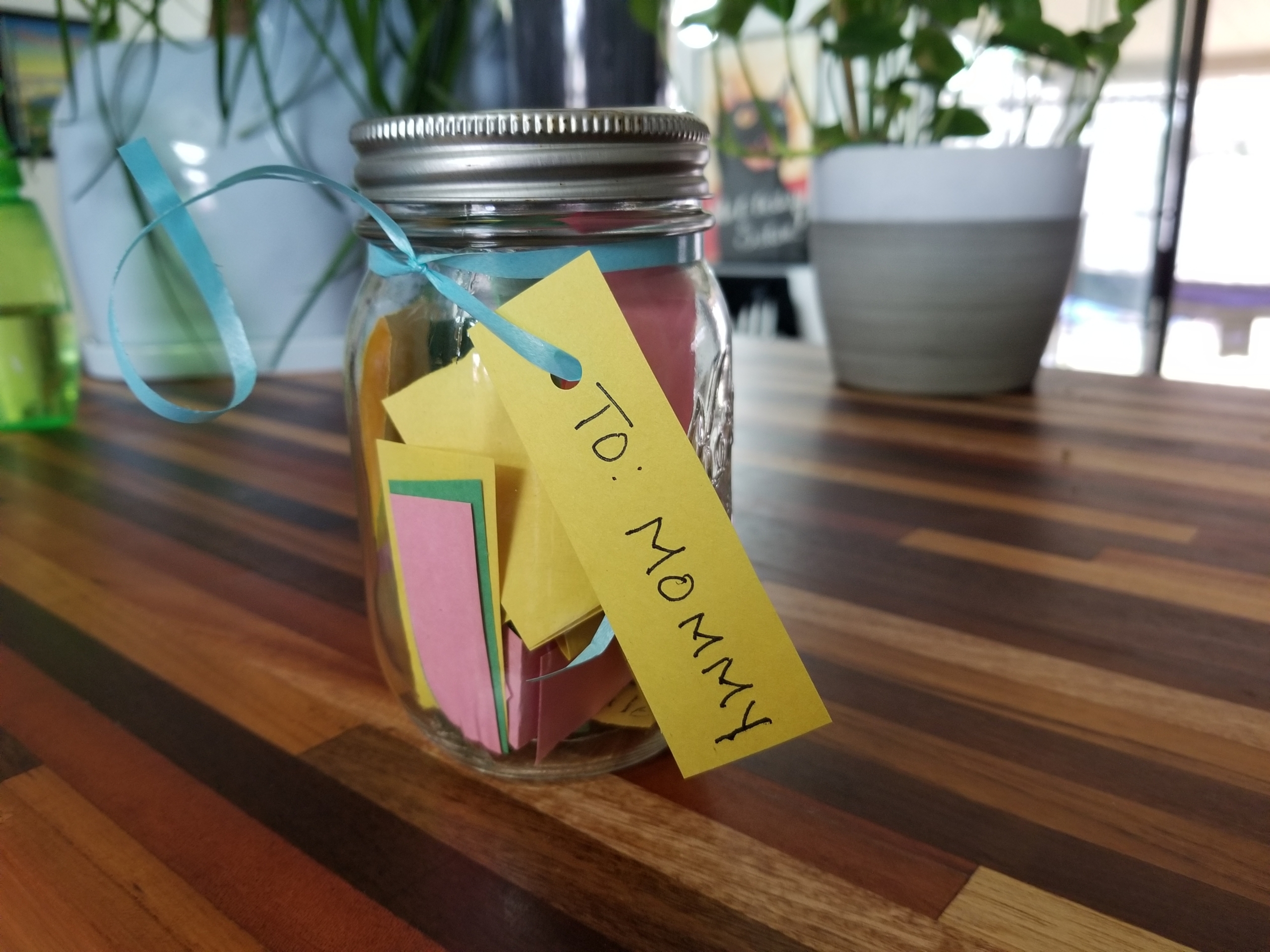
Step 7: Tie a ribbon or string around the jar and attach it to a tag with the recipient’s name on it. Now it’s ready to share!
Remember, the writing doesn’t need to be perfect! If your child needs help sounding out words or asks which way a letter faces, you can help them. However, allowing them to sound things out and make mistakes is all part of the learning process, so don’t stress out when vowels get dropped or there is a backwards R here and there. It’s about progress, not perfection.
And letting mom or other loved ones know how much they mean to your family—that’s the most important part of all.
Share with us on Instagram (mention @mayasmarty or use the hashtag #litrich) or in the comments what you put in your jar. And remember, keep your DIY Mother’s Day gift a surprise until the big day. Mum’s the word!
By Michelle Luke
Rhyming is a fun and effective way to support early literacy. It familiarizes children with the sounds that make up words, highlighting ending sounds in particular—and fostering phonological awareness, or the recognition of discrete sounds within a word. It creates a fun way for children to remember stories that they create through the pairing of common endings. And it also plants in youngsters an innate sense of syncopation, beat, and rhythm that they can later transfer to their own writing.
In this sweet Easter craft and activity, you’ll learn how to make an easy but adorable Rhyming Rabbit Easter Bunny puppet. Then you’ll help your child use their bunny to recite rhymes, from nursery rhymes and songs they know to beginner poems to come up with themselves. Using the bunny makes rhyming more fun, but it also has a deeper benefit: Reciting through a puppet can help children feel less self-conscious and free your budding poet or songster to get as lyrical or silly as they like.
See 4 Brilliant Ways Nursery Rhymes Prepare Kids to Read and Write to learn more about the power of rhyming.
Materials:
- Paper lunch bag (or any paper bag)
- Plain paper
- Scissors
- Glue, glue stick, or tape
- Colored pencils, crayons, or markers
- Printer (optional)
Cost: Nothing, if you have these simple materials on hand.
Step 1: Draw a bunny head for your puppet (or print our free printable bunny puppet template, below), then cut it out and paste it over the base of your upside-down bag as shown in the picture below. Important: The bunny’s head should approximately cover the base of your bag. If you use the bunny template, you may need to scale the image to print at the right size for your bag. Then invite your child to color or decorate the bunny.
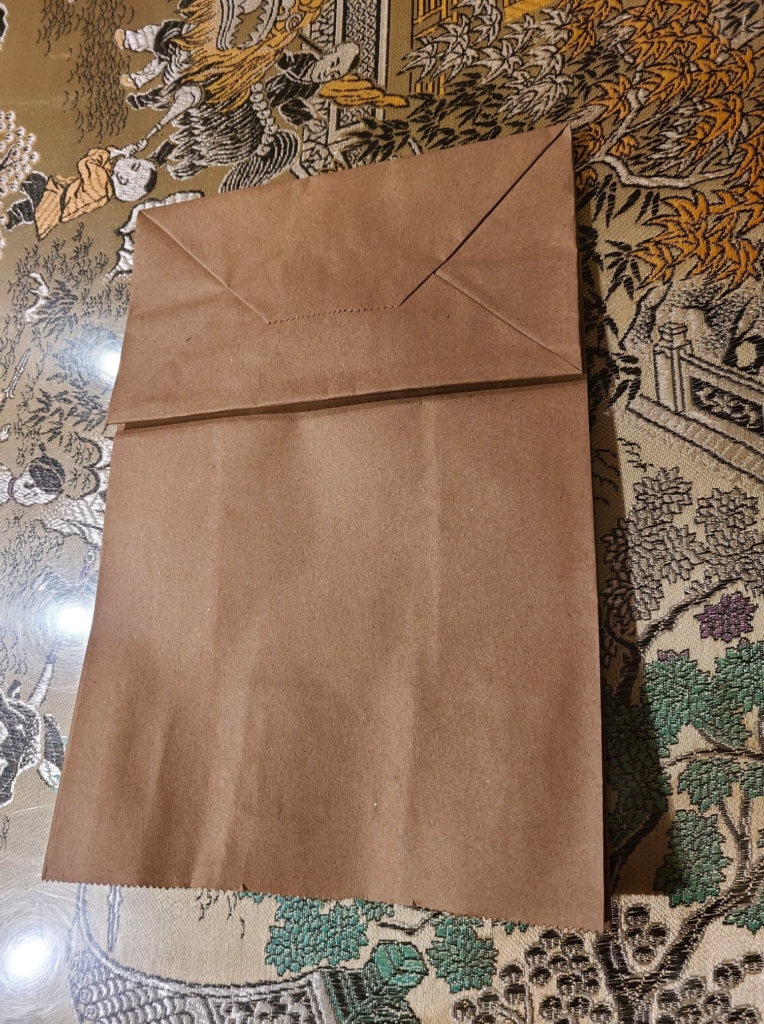
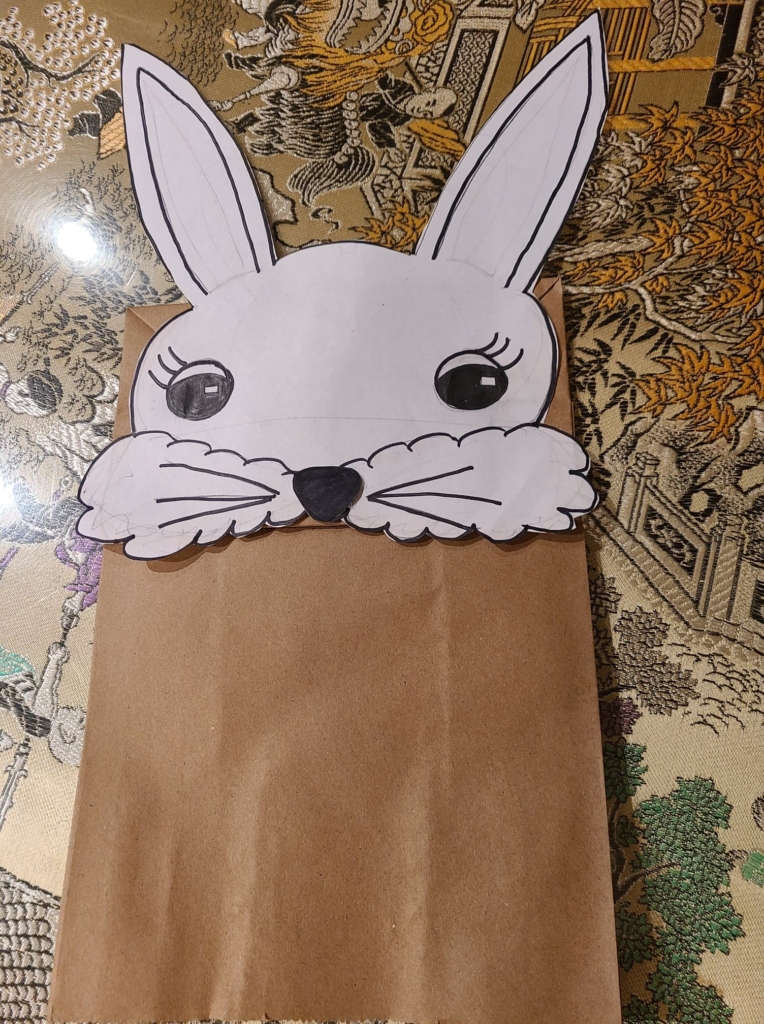
Step 2: Next, draw a mouth or cut out the mouth from your free bunny template. Attach the bunny’s mouth just below the bag’s top flap that the head is attached to, right at the crease that creates the base of the bag, as shown below.

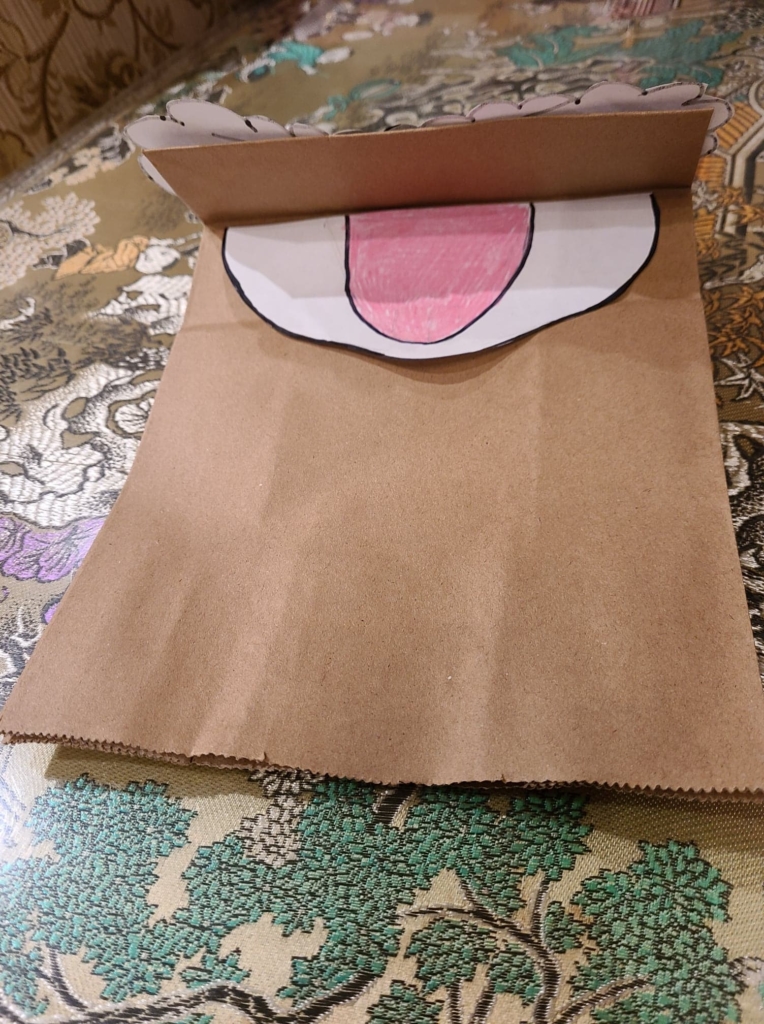
Step 3: Finally, draw bunny feet and a cottontail, or cut them out from the template. Attach the feet at the base of the bag. Flip over and attach the tail to the back of the bag.
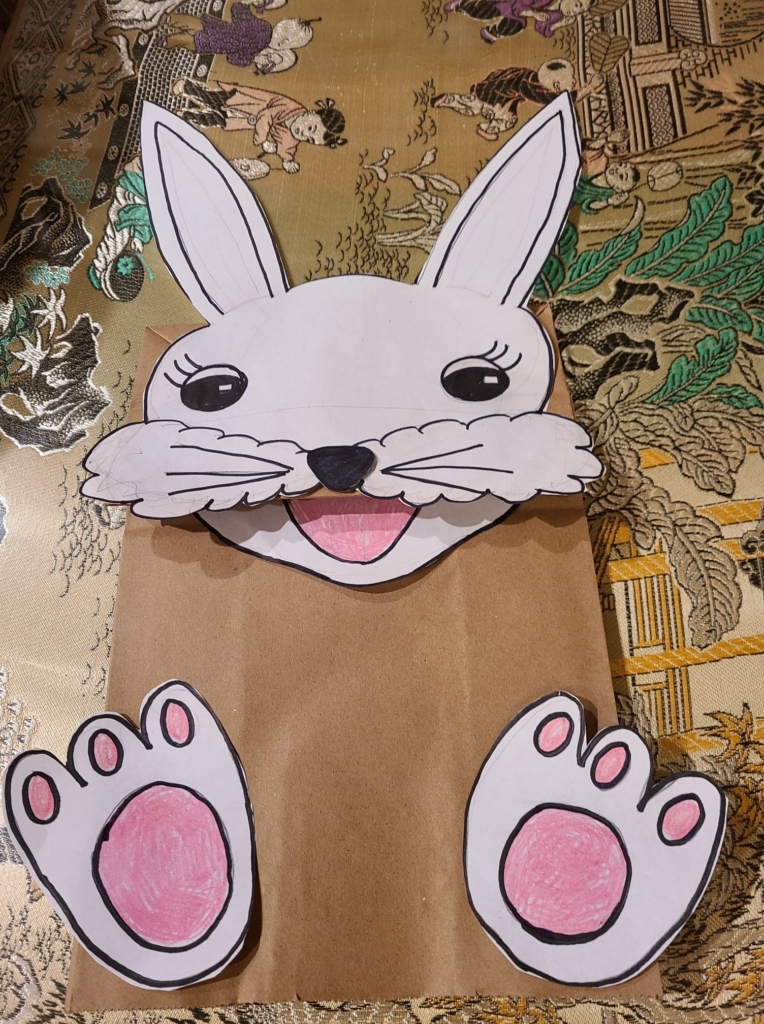
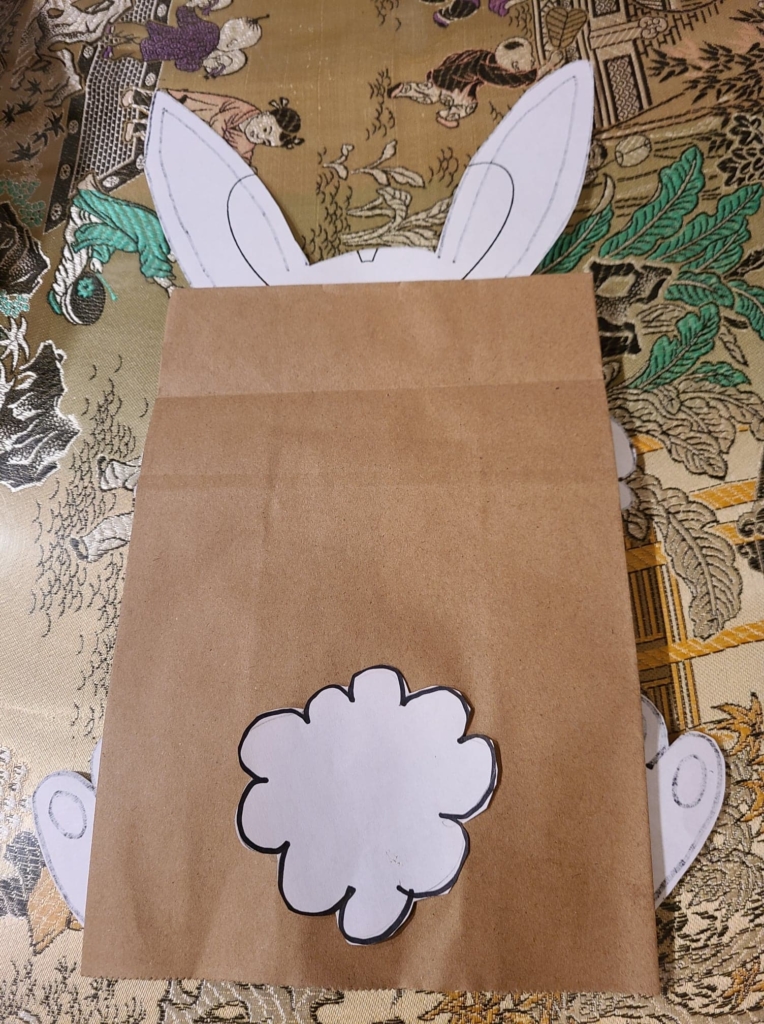
And your Rhyming Rabbit puppet is complete! Now your child can use it to read or sing poetry that they develop with you. Start them off by modeling how to use their puppet to recite a favorite nursery rhyme, Easter song, or spring-themed poem—or make up your own rhyme on the spot. Then help your little one develop a poem of their own.
Here’s how: Give some examples of rhyming words, and then have them join you in shouting out a word that rhymes with the last word you said. Jot them down—or help older kids write the words themselves—and then demonstrate how to recite them in rhythm to feel like a poem. This may be enough for the littlest children; for older kids, show them how to add a few words to make short lines that each end in one of the rhyming words. Have fun!
We’d love to see what you do! Share pictures of your puppet on Instagram and tag @mayasmarty.
Enjoyed this tutorial? Share it!



